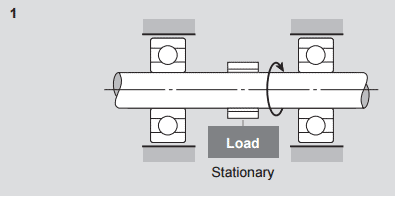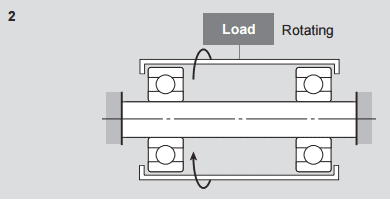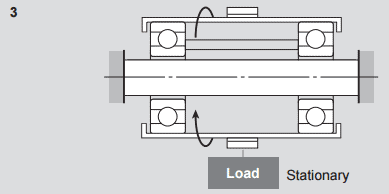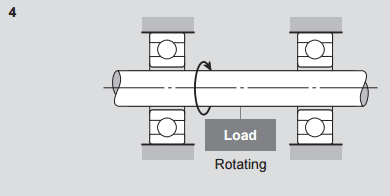It is important to choose the right fit to prevent slippage between the bearing ring and the surrounding structure. If this kind of creep occurs, the fitting surfaces wear away and cause damage to the shaft. Metal grindings can also end up inside the bearing, causing damage and resulting in unwanted heat and vibrations. A number of factors have to be taken into account when choosing the right fit, such as the magnitude and type of the bearing load, temperature differences, and the tools used to assist with fitting and dismantling.
As a rule, creep can be prevented by securing the ring with sufficient interference. If the bearing is only subject to point loading, press fits are not normally needed for the rings. Sometimes, fits are made without inner and outer ring interference to cater for certain operating conditions or to make installation and removal easier. In such cases, damage to the fitting surfaces can be avoided by means of lubrication.
Load conditions and fits
The right fit can be selected by looking at the load and the operating conditions.




| Loading point | Bearing operation | Load conditions | Fit | ||
|---|---|---|---|---|---|
| Inner ring | Outer ring | Inner ring | Outer ring | ||
| 1. Stationary load | Rotating | Stationary |
Rotating load on inner ring Stationary load on outer ring |
Tight fit | Loose fit |
| 2. Rotating load | Stationary | Rotating | |||
| 3. Stationary load | Stationary | Rotating |
Rotating load on inner ring Stationary load on outer ring |
Loose fit | Tight fit |
| 4. Rotating load | Rotating | Stationary | |||
| Indeterminate direction of load due to changes in direction or asymmetrical loading | Rotating or stationary | Rotating or stationary | Indeterminate direction of load | Tight fit | Tight fit |
Magnitude of load and interference
The bearing load slightly reduces the inner ring interference. This reduction can be calculated using the following equation:

The effective interference Δd should be larger than the interference resulting from the equation.
If the radial load exceeds 20% of the basic static load rating C0r, the interference may be too small in these operating conditions. With this in mind, the interference should be calculated with the aid of this equation:

Interference deviation due to temperature differences between the bearing and the shaft or housing
As the bearing temperature rises during operation, the effective interference is reduced. The reduction in inner ring interference resulting from this difference in temperature ΔdT can be calculated using the equation below:

The interference can also increase due to differences in temperature between the outer ring and the housing or differences in the coefficients of expansion.
Effective interference and surface finish of the shaft and housing
As the fit reduces the roughness of the fitting surfaces, the effective interference is lower than the apparent interference. The roughness of the surface determines the extent to which the interference is diminished. The latter can be calculated with the aid of the following equations:

According to these equations, the effective interference of bearings with a bore diameter of 30 to 150 mm is approximately 95% of the apparent interference.
Compressive stress, ring expansion and contraction
When bearings are installed on a shaft or in a housing with interference, the rings either expand or contract. Stress also occurs. Excessive interference can damage bearings, which is why the maximum interference should always be kept below approximately 7/10,000 of the shaft diameter.
Recommended fits
If the housing is thin or the bearing is installed on a hollow shaft, a tighter than normal fit must be used. Split housings often cause oval deformation within the bearing, so split housings should not be used if a tight fit is needed for the outer ring.
A tight fit should be used for both the inner and outer ring in applications where the shaft is exposed to strong vibrations.

